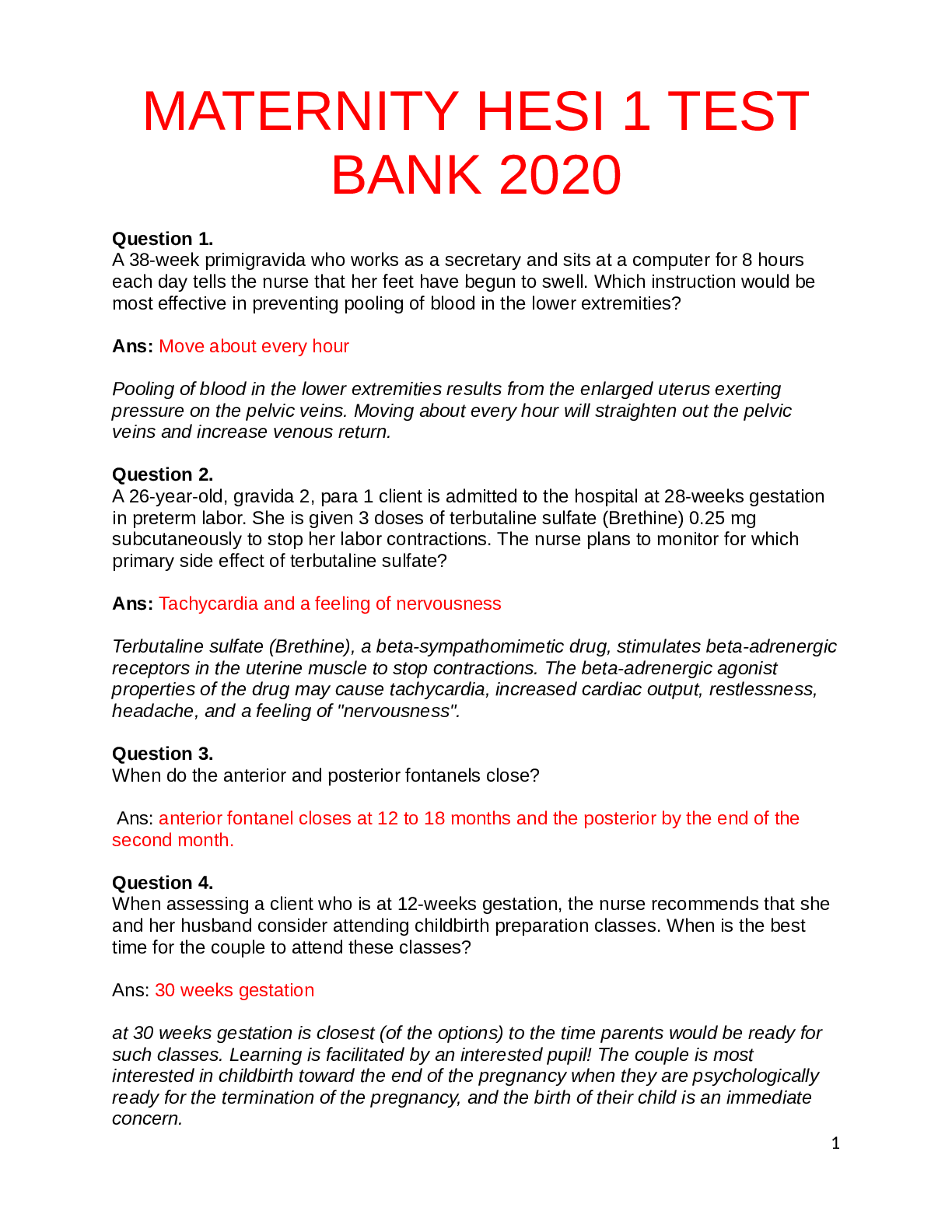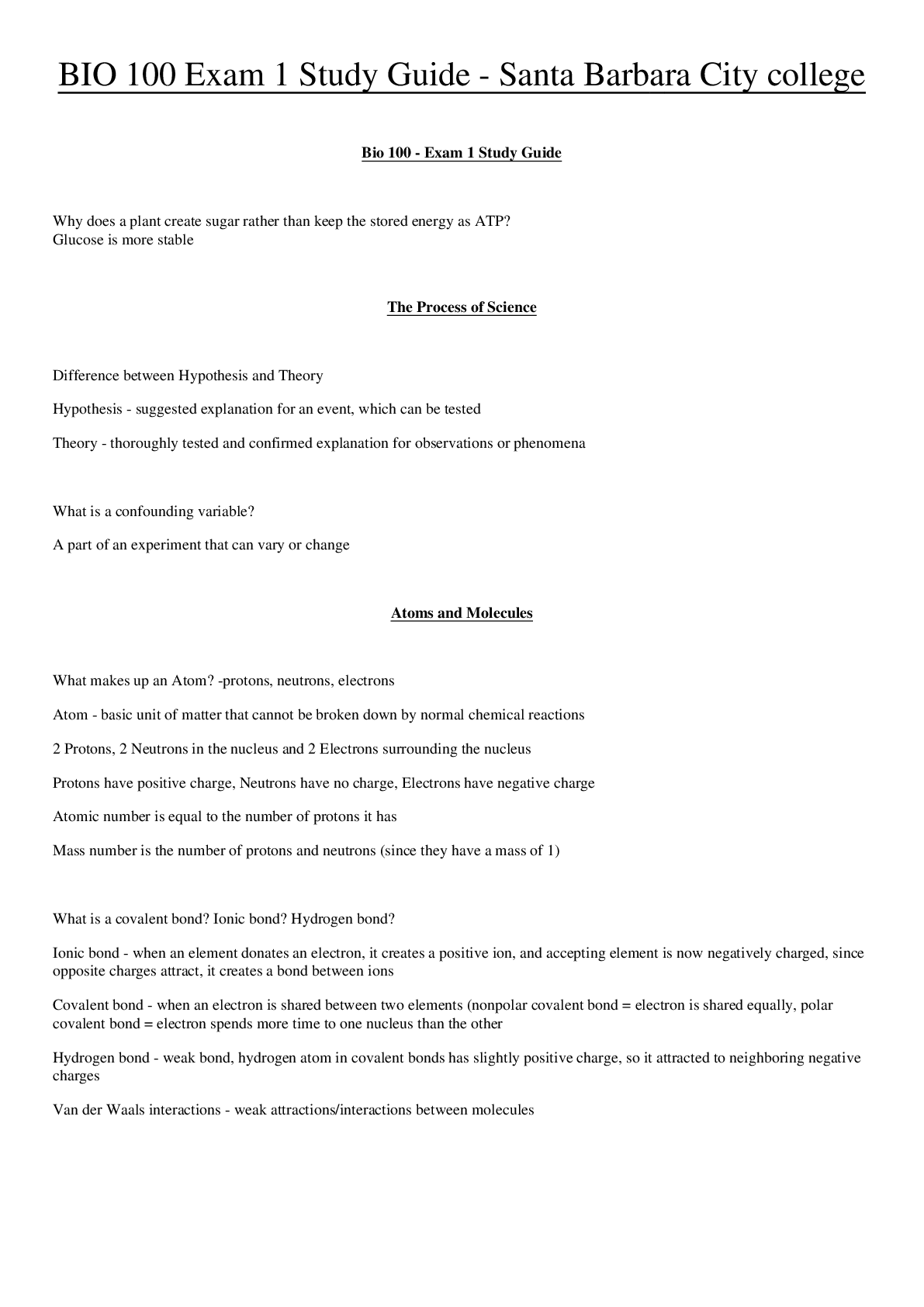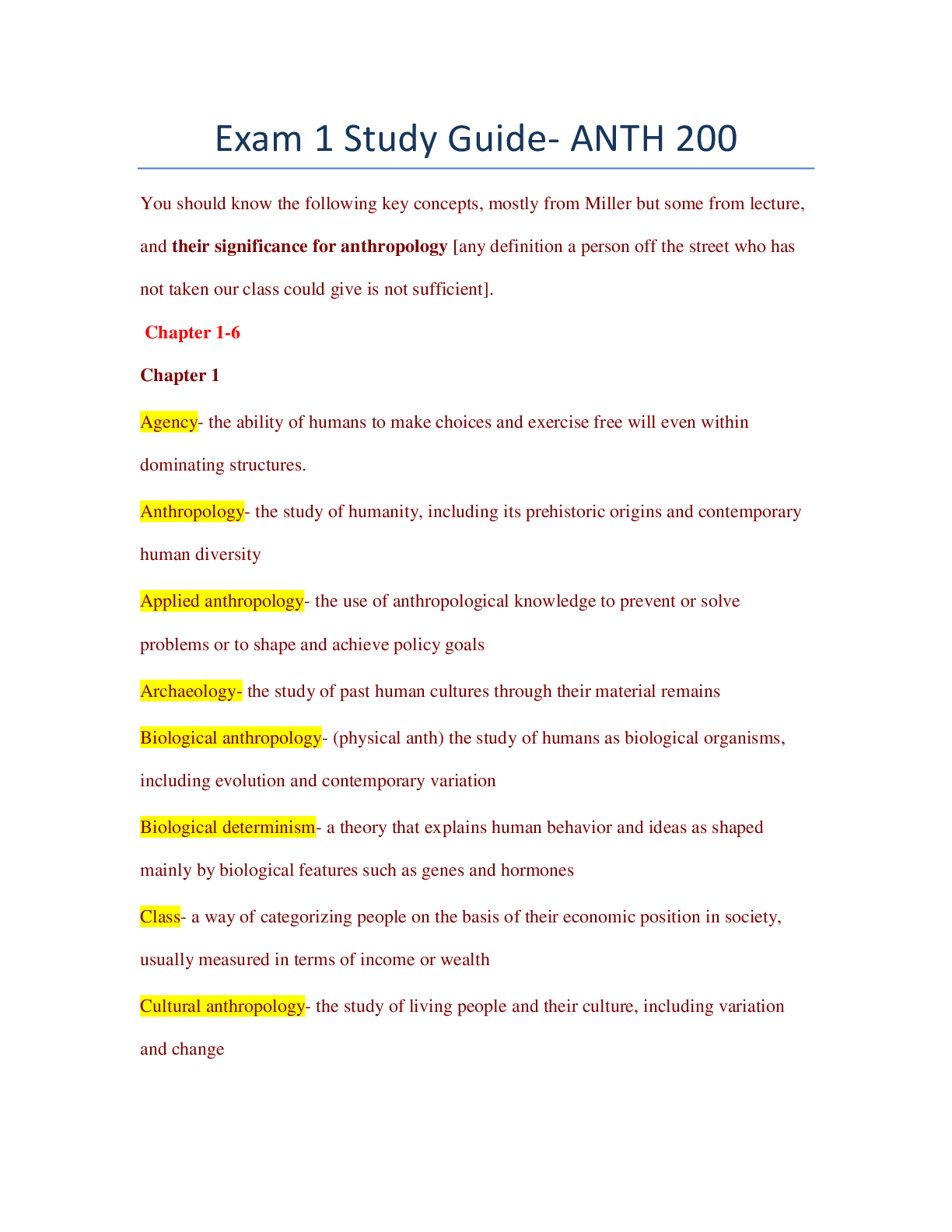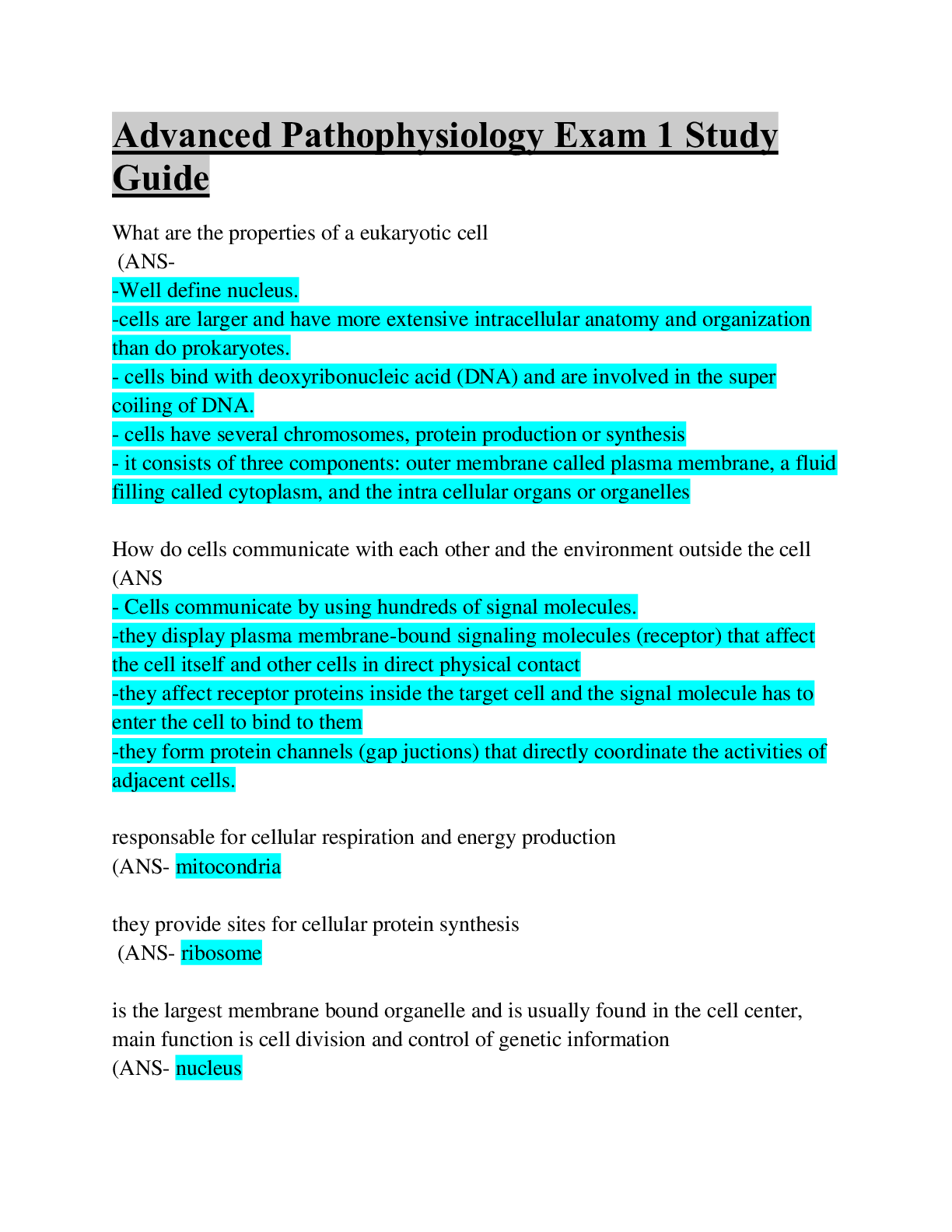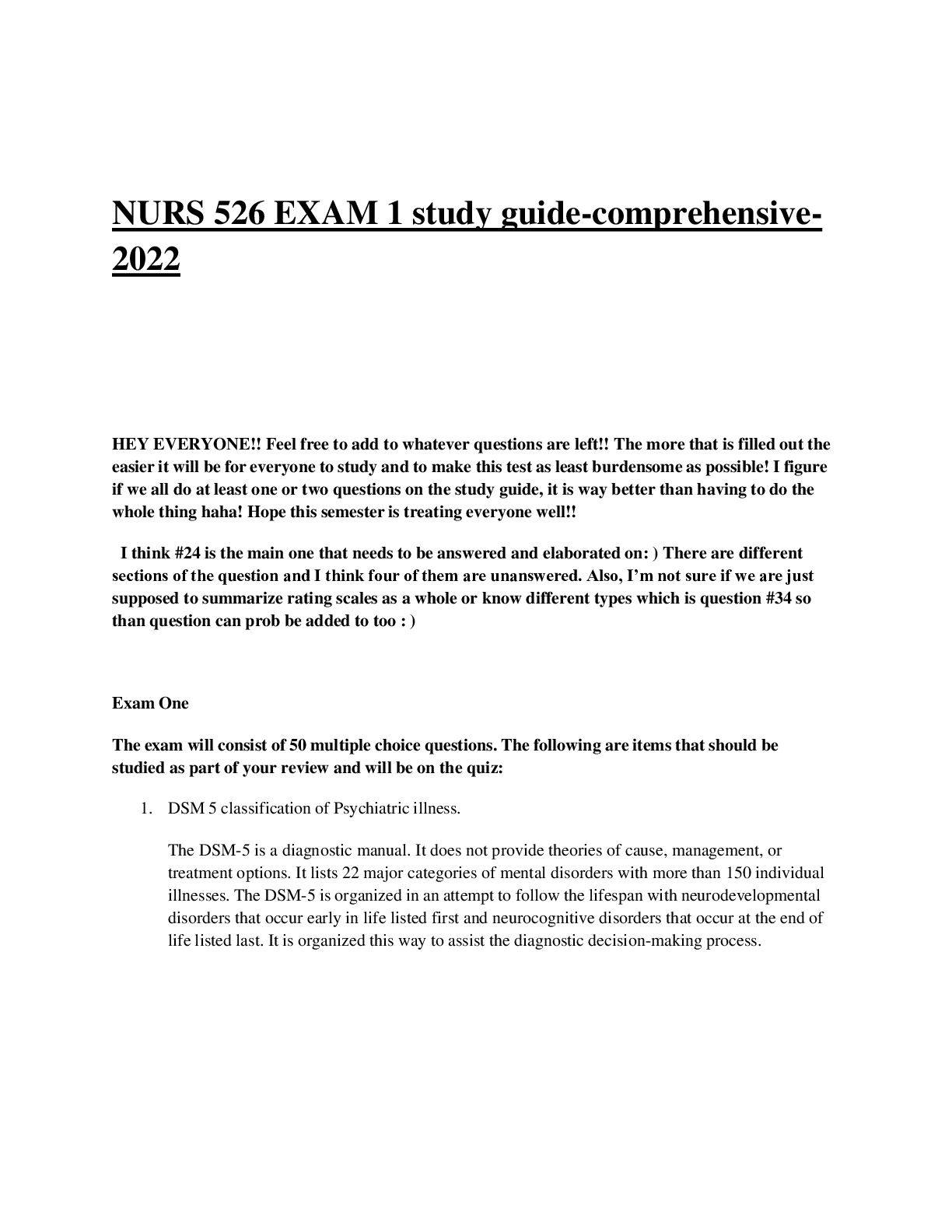*NURSING > STUDY GUIDE > NUR 2488 Mental Health Exam 1 Study Guide Complete (All)
NUR 2488 Mental Health Exam 1 Study Guide Complete
Document Content and Description Below
Assess Your Knowledge Mental Health Exam 1 Discuss prominent theories and therapeutic models o Behavioral Therapy: attempts to correct or eliminate maladaptive (bad) behaviors/responses by rewardi... ng & reinforcing adaptive (good) behavior. Use of Desensitization, Aversion Therapy (becoming not afraid of spiders), Biofeedback and Modeling as well as the below 3 items. Pavlov, Watson & Skinner Pavlov: Classical Conditioning (Ex: baby cries and mom has milk “let-down” reflex). Watson: Personality traits & responses were learned (conscious) behavior. Skinner: Operant Conditioning. Behaviors are learned through Positive/Negative Reinforcement (Ex: studying hard results in good grades). o Cognitive Behavioral Therapy: combines both behavioral and cognitive theory and seeks to modify negative thoughts that lead to dysfunctional emotions & actions. This is useful for those patients who feel incompetent, abandoned, evil or vulnerable. It is NOT the stimulus (situation/person/place/thing) that causes the response; it is the person’s evaluation & selfthoughts about the situation that causes the negative feelings/reaction. Therapy aims to remove these negative/repetitive thoughts and replace them with rational interpretations of situations. Ex: “Matt had a car accident. He now refuses to drive and says, “I shouldn’t be allowed on the road”. (This is distorted thinking and rationalization of his car accident). o Milieu Therapy: Creating a SAFE, structured inpatient/outpatient setting where the mentally ill can test new behaviors and coping mechanisms with others. Creating a SAFE, structured inpatient/outpatient setting where patients with mental illness can test new behaviors and interactions. Climate is essential to healing: paint color, relaxed environments are conducive to the healing process. Florence Nightingale believed that the environment helps heal o Maslow’s Hierarchy of Needs: Basic needs on the bottom of the pyramid have to be met before the top (self-actualization) can be attained. 1. Physiological Needs – most basic needs that a human needs (food, water, O2, sleep, sex, body temperature, elimination, voiding). This level takes priority over all others. Assess Your Knowledge Mental Health Exam 1 2. Safety Needs – security, protection, and freedom from fear/anxiousness/chaos, law, order and limitations. 3. Belonging & Love Needs – The need for love, affection, intimate relationships and belonging will see to overcome feelings of loneliness and alienation. (Having a Family and a Home is very important). 4. Esteem Needs – If this need is met, we feel confident, valued and valuable. If this need is NOT met, we feel inferior, worthless and helpless. 5. Self-Actualization – What we strive to become as humans. Fulfillment of this need brings inner piece and contentment with ones self. Describe the role of neurotransmitters: dopamine, serotonin, and norepinephrine, GABA Dopamine: controls emotional responses, the brain’s reward and pleasure centers, stimulates heart and increases blood flow to organs. (Haloperidol = dopamine blocker). Cocaine allows more of dopamine to stay active for longer = increased HR, etc. o EPS is the result of Dopamine blockers (Dopamine needs to get through for proper brain functioning!) o Disorders with HIGH levels: Schizophrenia, Mania o Disorders with LOW levels: Depression, Parkinson’s Disease Serotonin: Regulates mood, arousal, attention, behavior, and body temperature. Most anti-depressants increase Serotonin production. Muscle Relaxants block serotonin production. Serotonin release by platelets play important role in homeostasis. o High levels of Serotonin S/Sx: causes restlessness, shivering, diarrhea, muscle rigidity, fever and seizures. o Disorders with HIGH levels: Anxiety o Disorders with LOW levels: Depression Norepinephrine: Regulate mood. A deficiency can cause Depression and excess can cause Mania. o Disorders with HIGH levels: Mania, Anxiety, Schizophrenia o Disorders with LOW levels: Depression GABA: inhibitory neurotransmitter that regulates excitability and helps treat anxiety by helping you “chill out”. Anti-Anxiety Meds help increase the effectiveness of GABA by making the receptors more responsive. o Disorders with HIGH levels: Reduction of Anxiety o Disorders with LOW levels: Mania, Anxiety, Schizophrenia Describe the phases of the nurse-client relationship, and what occurs during each phase (Hildegard Peplau) 1. Orientation Phase: first time the nurse & patient meet, interact according to their own backgrounds/standards/values/beliefs, Assess Your Knowledge Mental Health Exam 1 roles of the patient and nurse are clarified, confidentiality is discussed and assumed, nurse becomes aware of transferences & countertransference issues, goals are established, termination terms are introduced. 2. Working Phase: exploration of feelings or situations that are causing the problems, re-experiencing of old conflicts can awaken high levels of anxiety, intense emotional states may surface, defense mechanisms, denying, manipulation, evaluation of problems and goals, promote alternative reactions/behaviors to situations, etc. The nurse’s awareness of his or her own personal feelings and reactions to the patient are VITAL for effective interaction with the patient. 3. Termination Phase: summarization of goals, review of what was achieved during communication, discussing new ways to implement new coping strategies, evokes strong feelings in both client & nurse. Describe the client interview- what should be considered and included What should be Considered: o The interview (content & direction) is lead by the patient. o The nurse uses open communication, positive attending behaviors, and active listening to better understand the patient’s situation. This allows the patient to feel understood, listened to, explore problems, healthy ways to meet emotional needs and have a satisfying interpersonal relationship experience. What should be Included: o Setting: has a large impact on healing (remember to use Milieu techniques) o Seating: stay between patient and door, avoid sitting behind a desk, sit at an angle with the chairs (not face-to face) o Introductions: who you are, purpose of meeting, length of meeting, confidentiality of meeting, asking patient how they like to be addressed (Blake vs. Mr. Anderson), etc. o Initiating Interview: use open ended questions like “Where should we start”, “Tell me what has been going on when you recently” o Offering Leads: “Go on…” o Making statements of Acceptance: “I follow you…” Helpful Guidelines o Speak briefly o When you don’t know what to say, don’t say anything o Focus on feelings Assess Your Knowledge Mental Health Exam 1 o Don’t give advice o Avoid relying on questions o Note patient’s non-verb [Show More]
Last updated: 1 year ago
Preview 1 out of 12 pages
.png)
Reviews( 0 )
Document information
Connected school, study & course
About the document
Uploaded On
May 02, 2022
Number of pages
12
Written in
Additional information
This document has been written for:
Uploaded
May 02, 2022
Downloads
0
Views
98



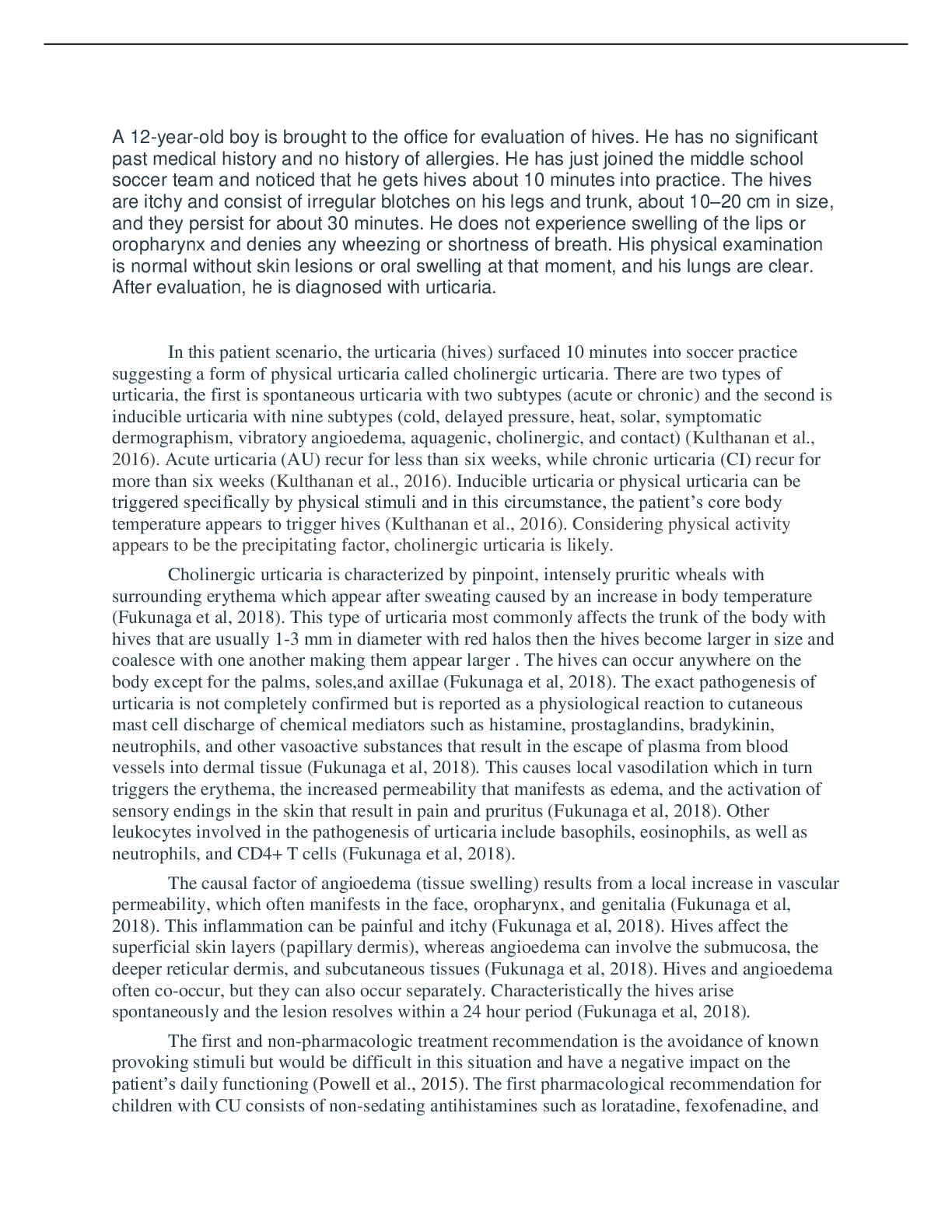
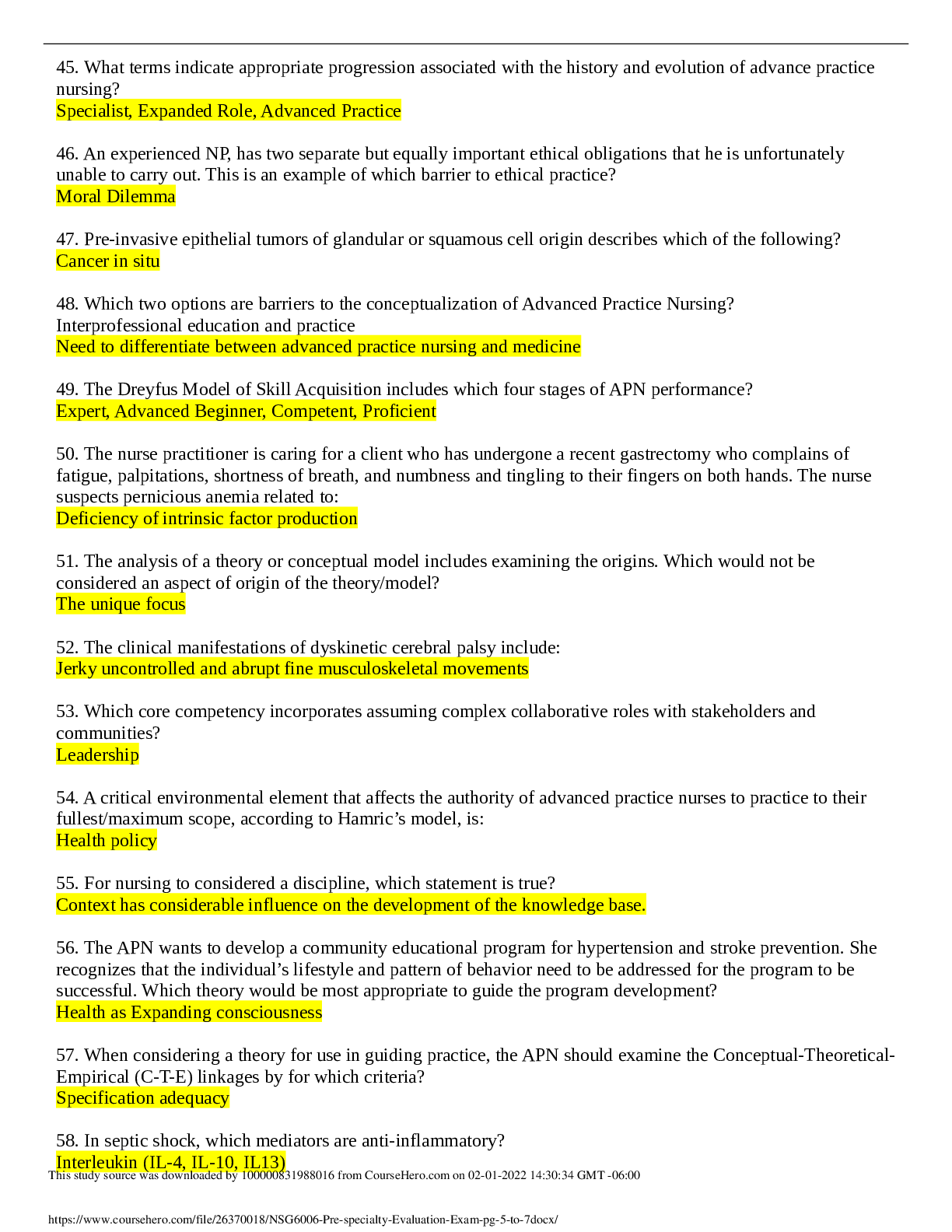


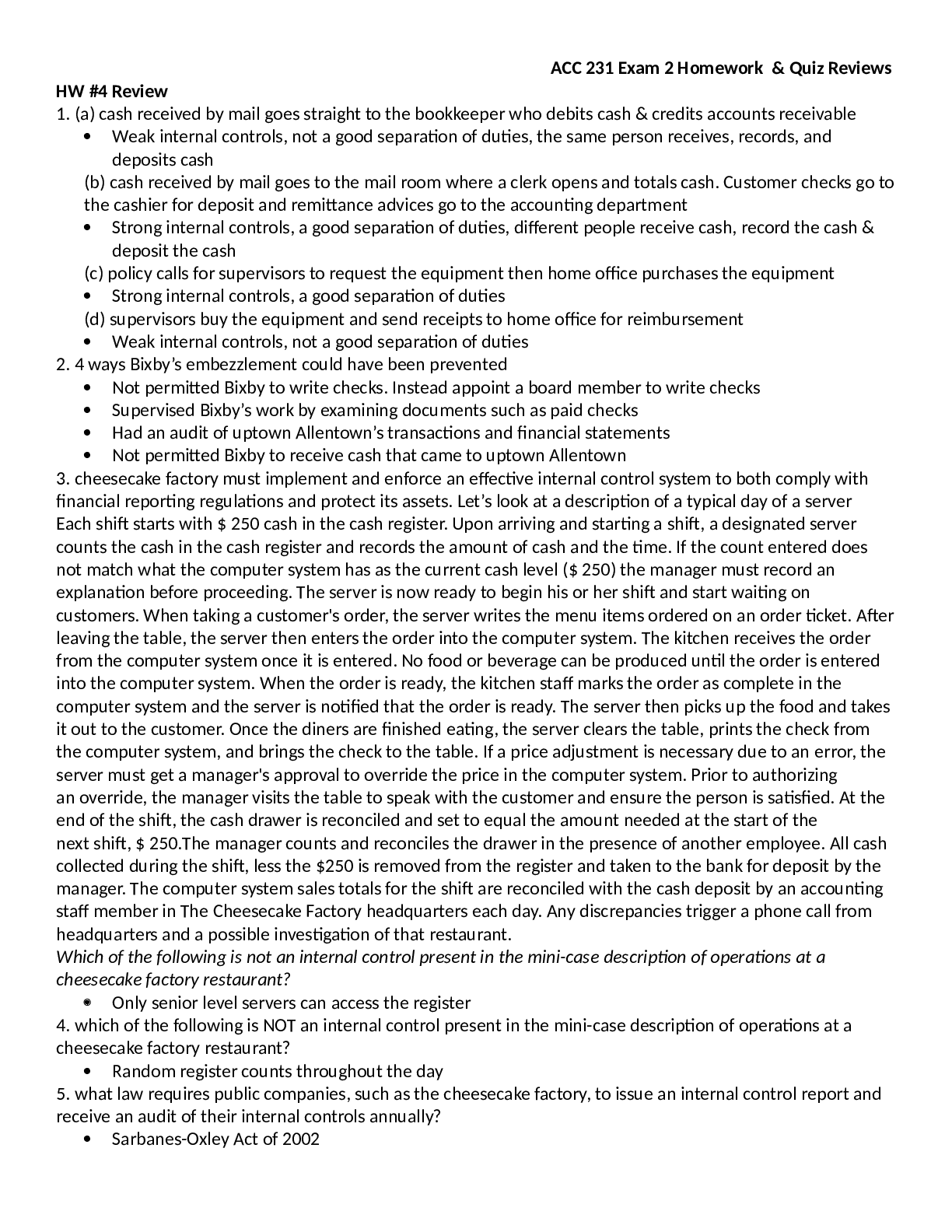

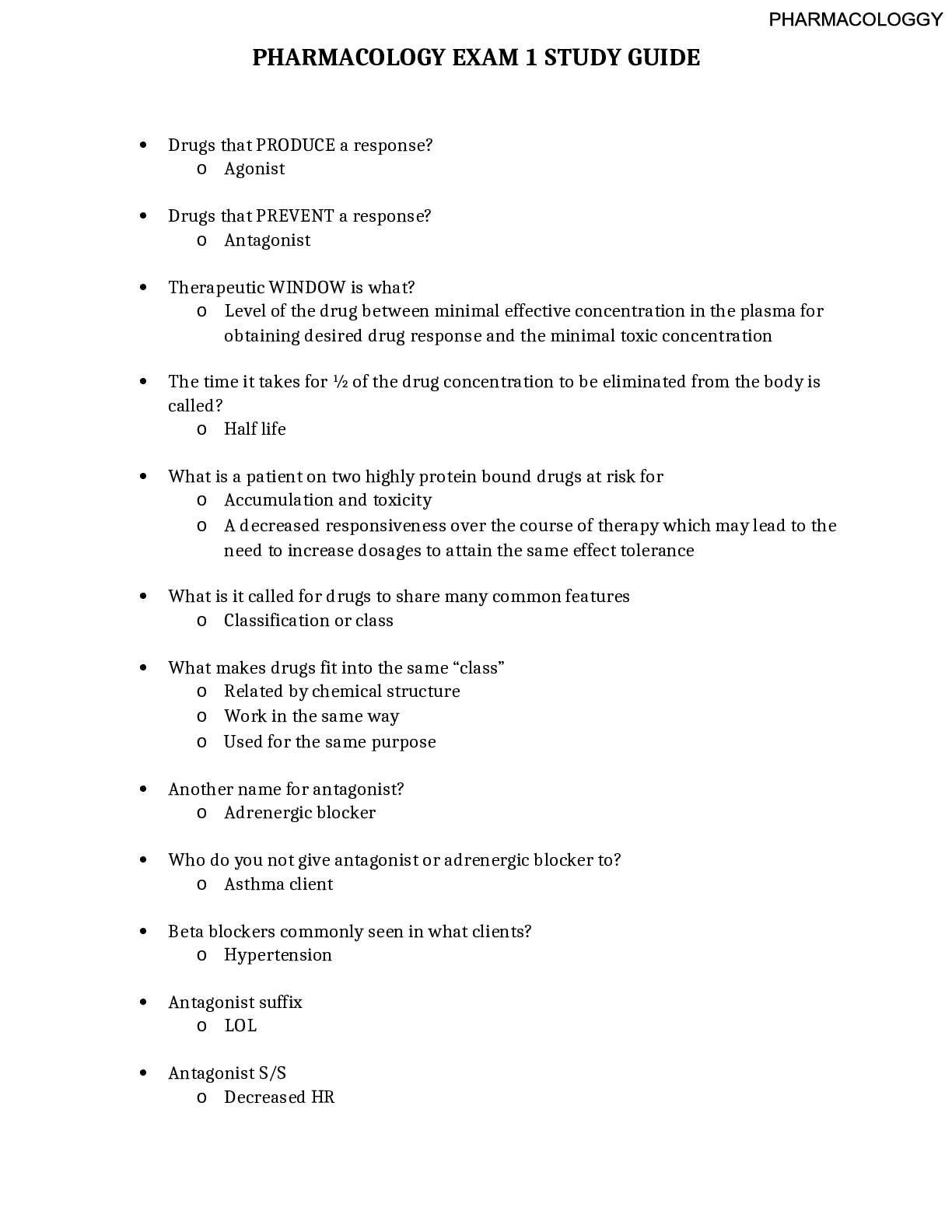
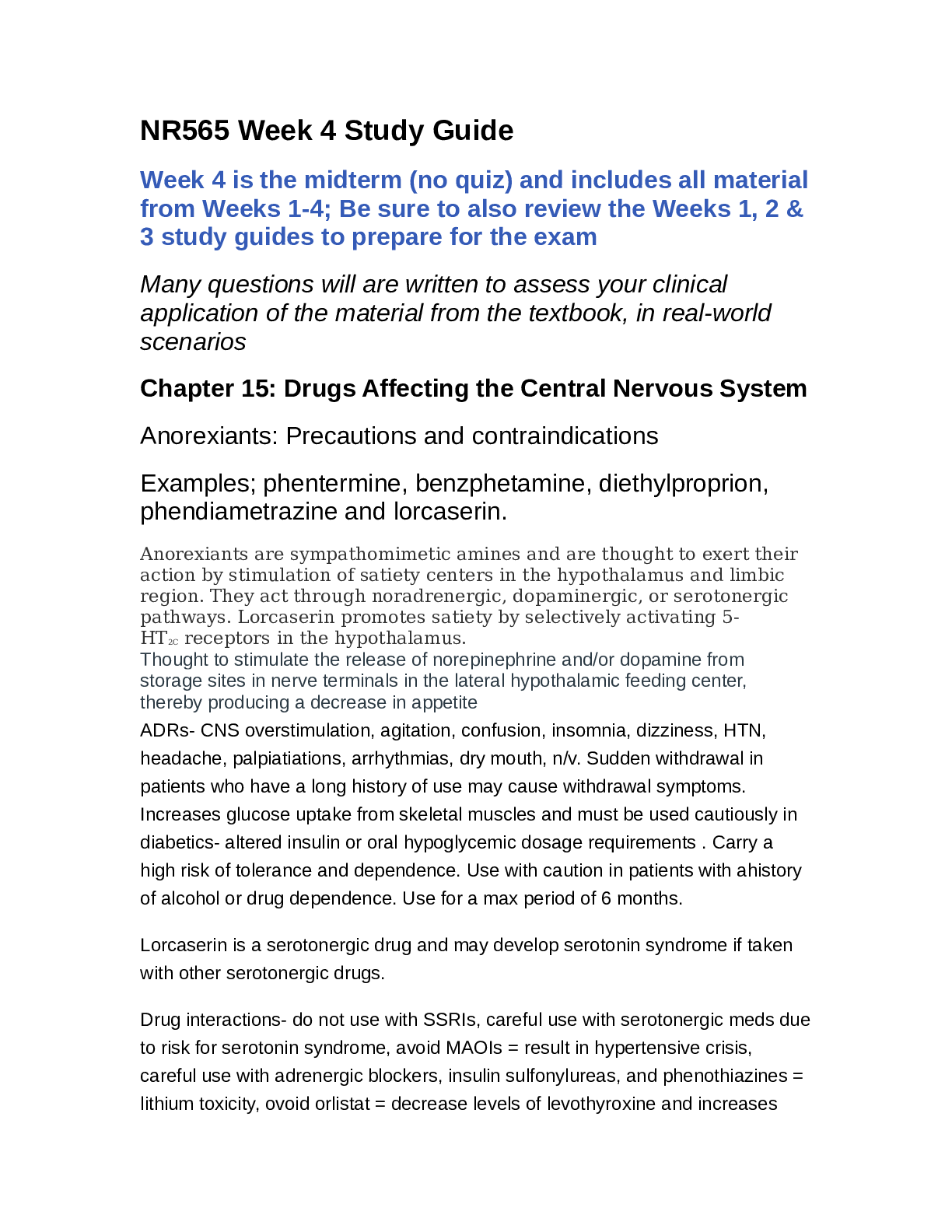



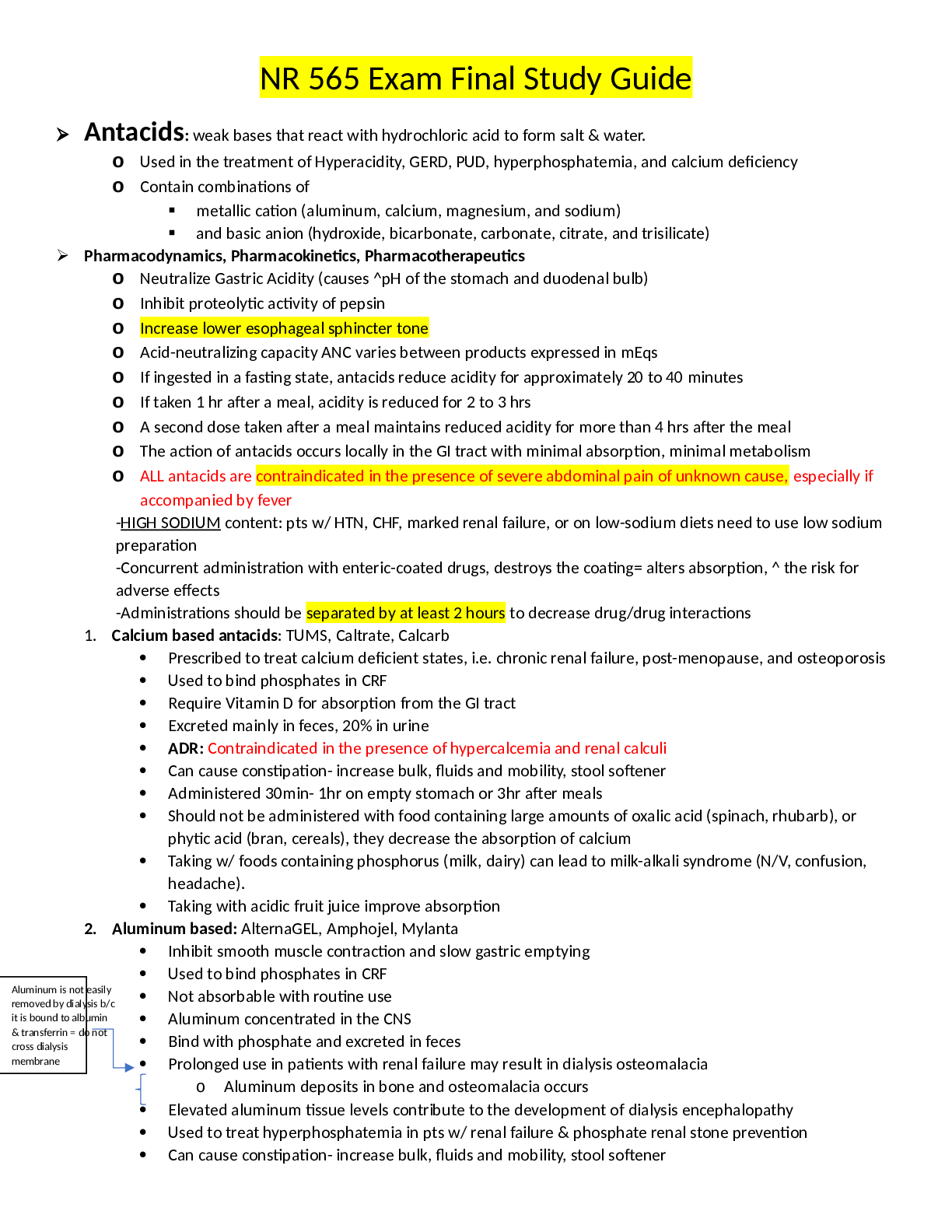

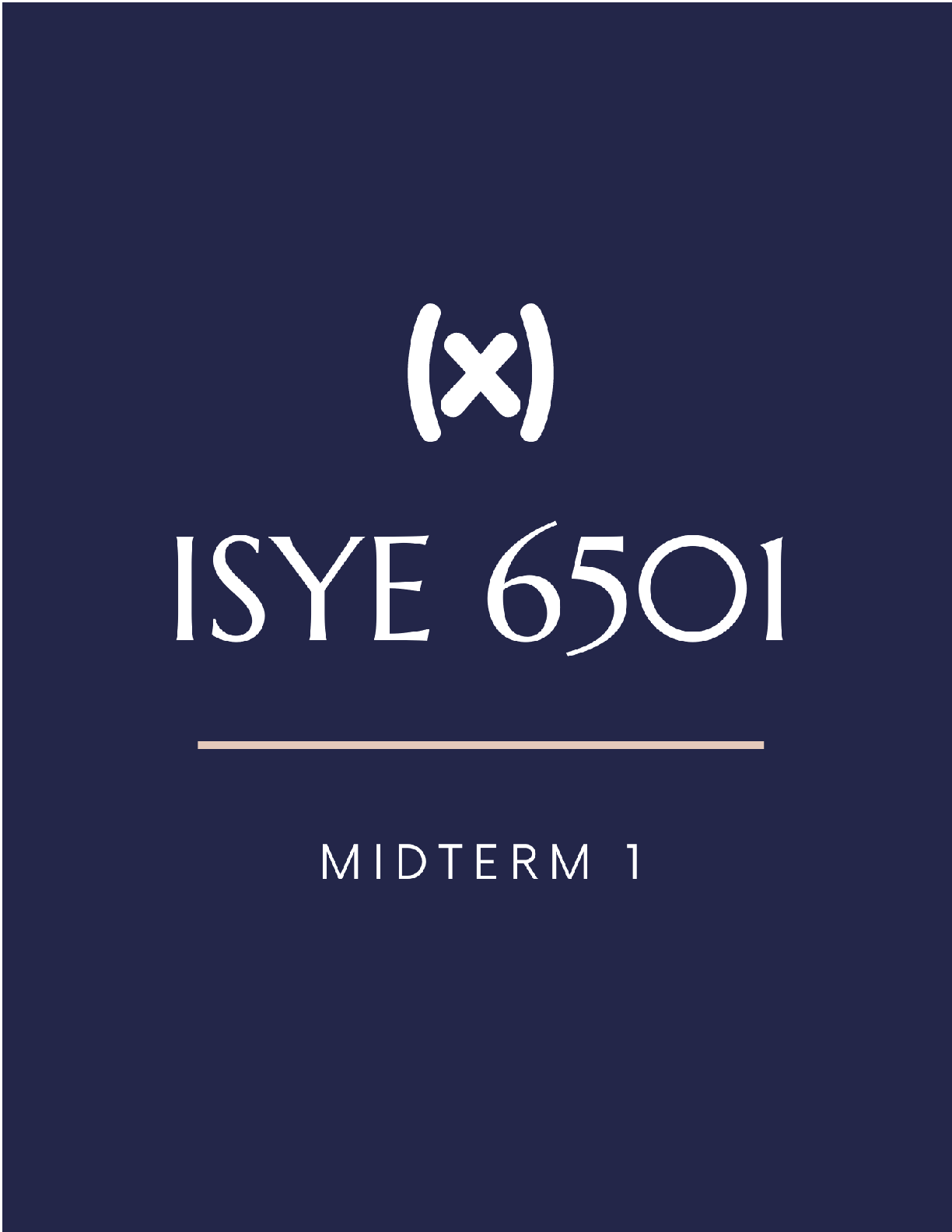
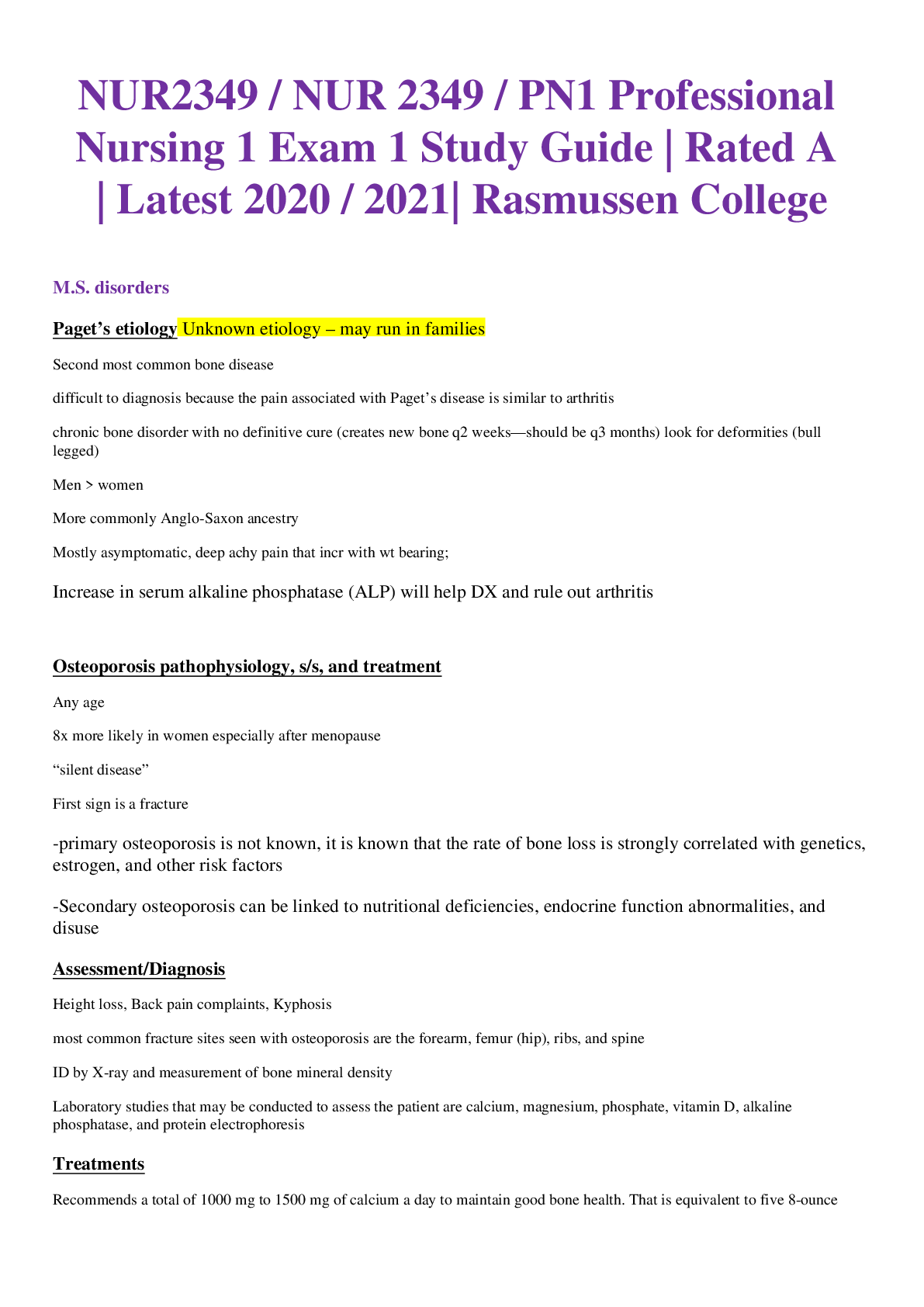
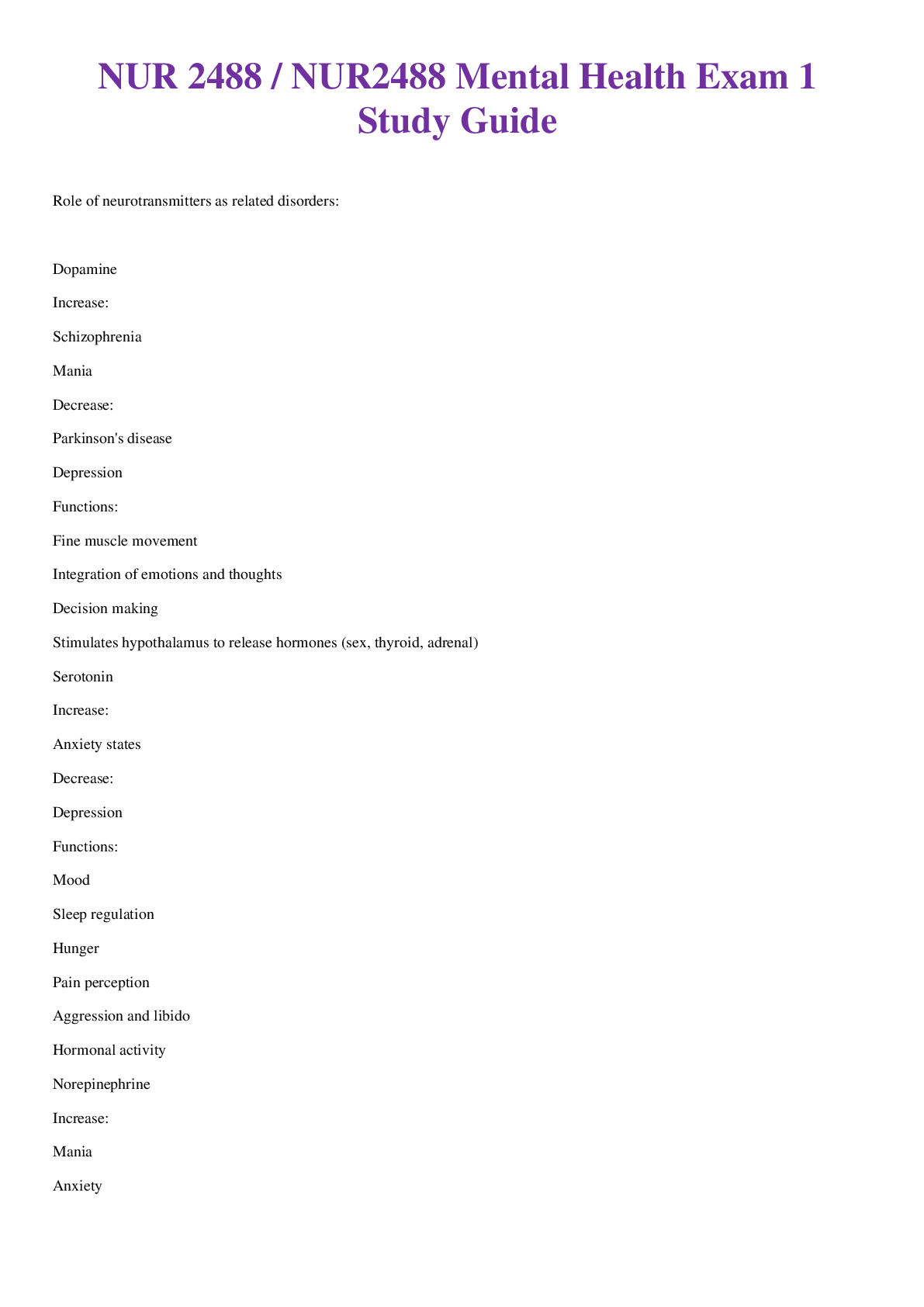
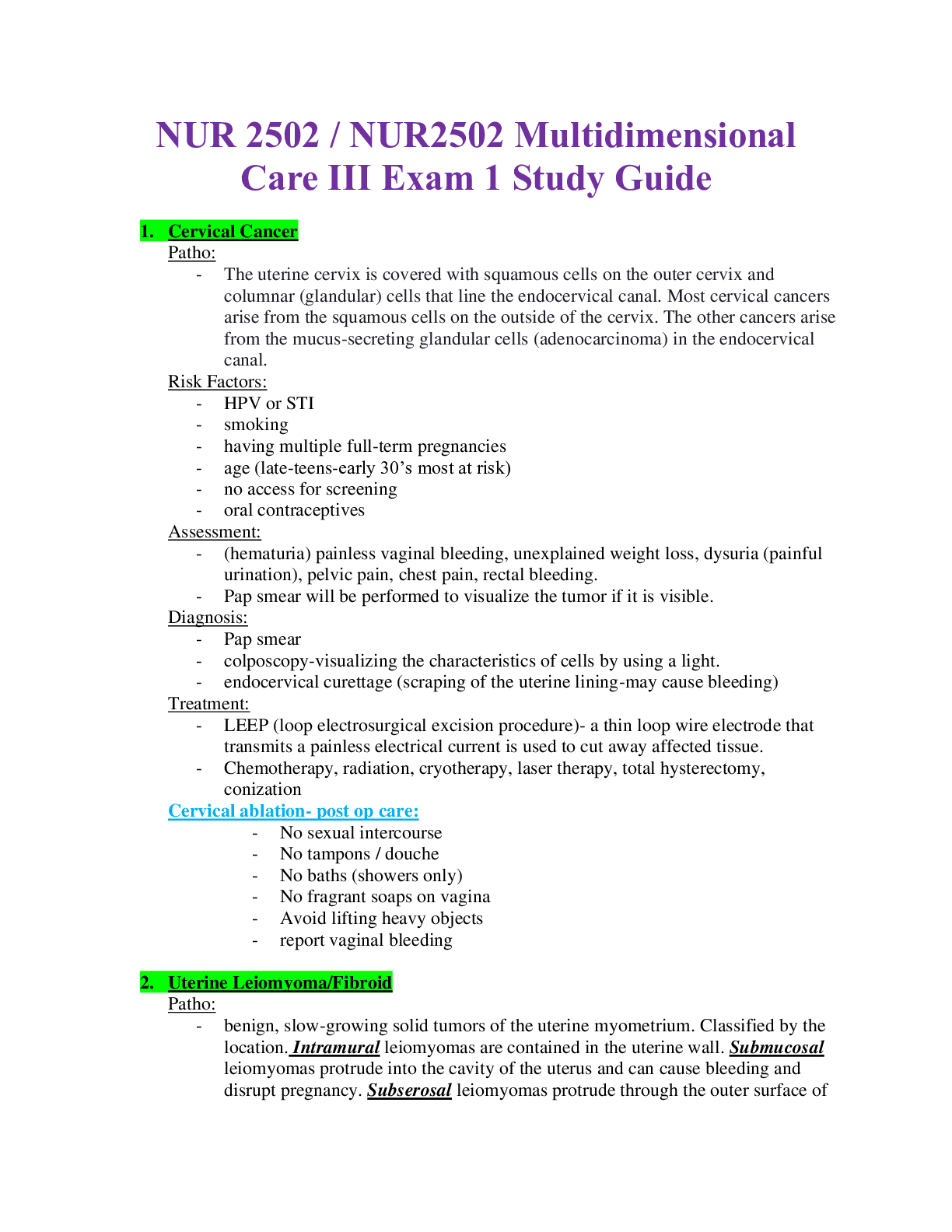
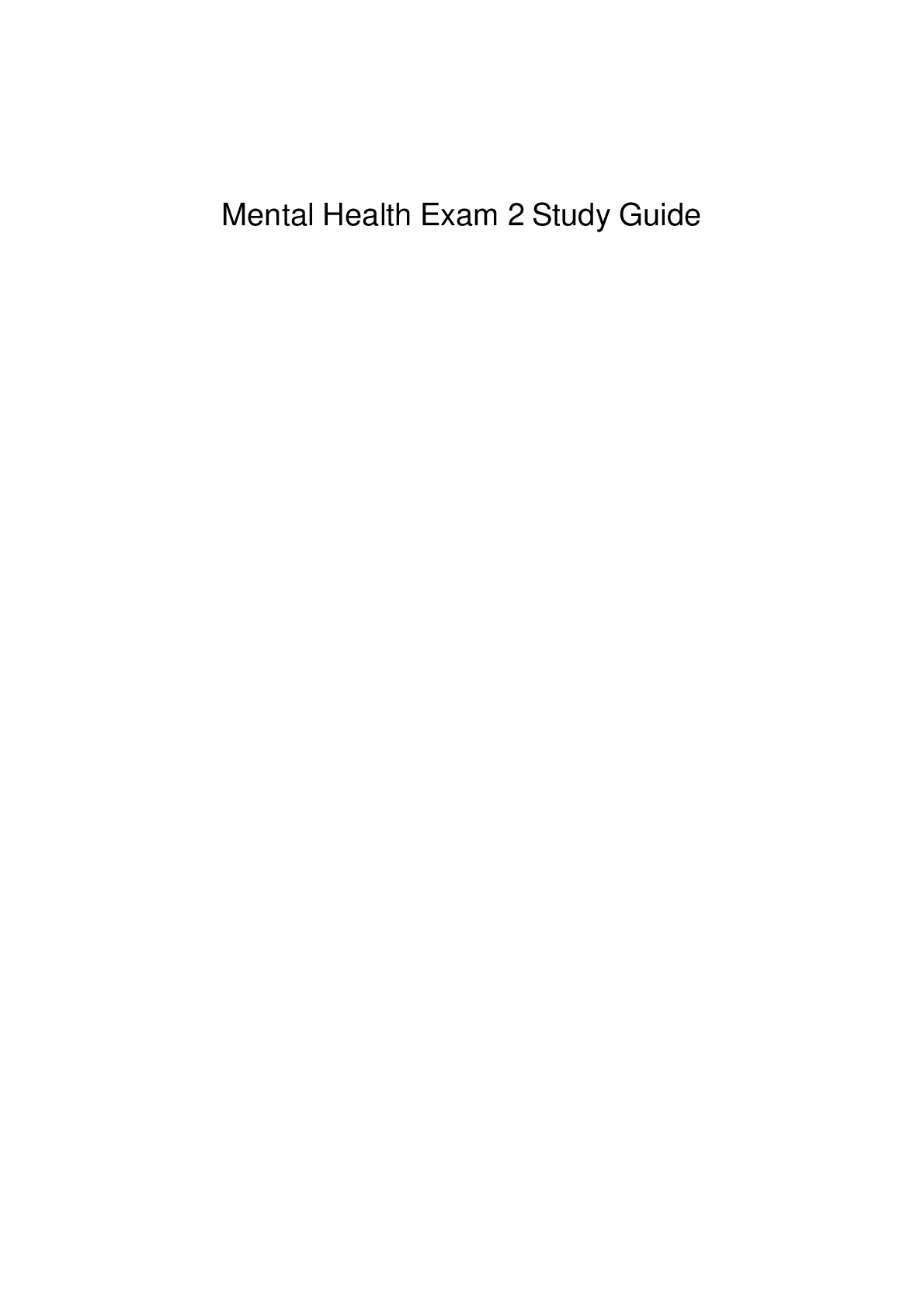
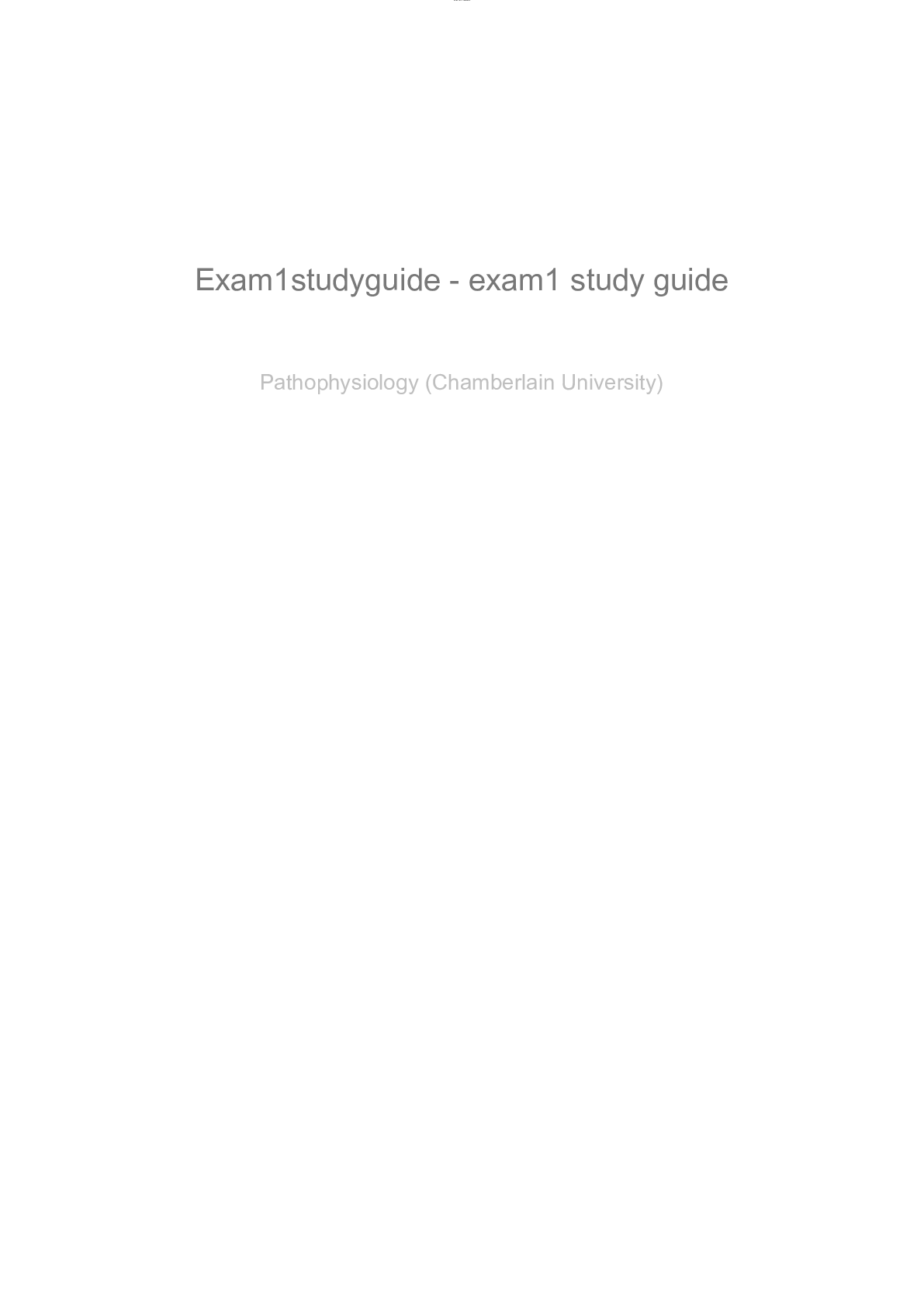
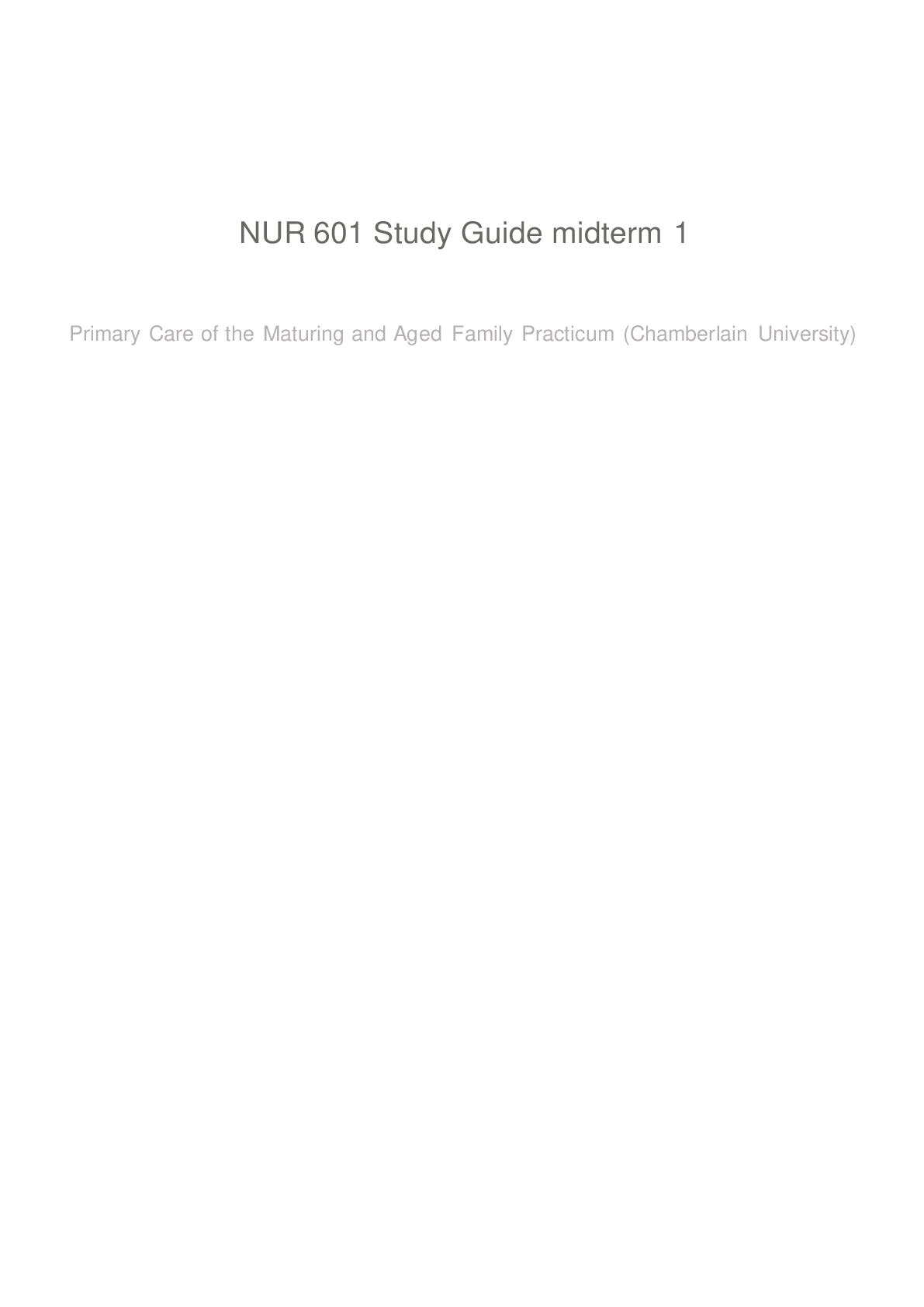
.png)
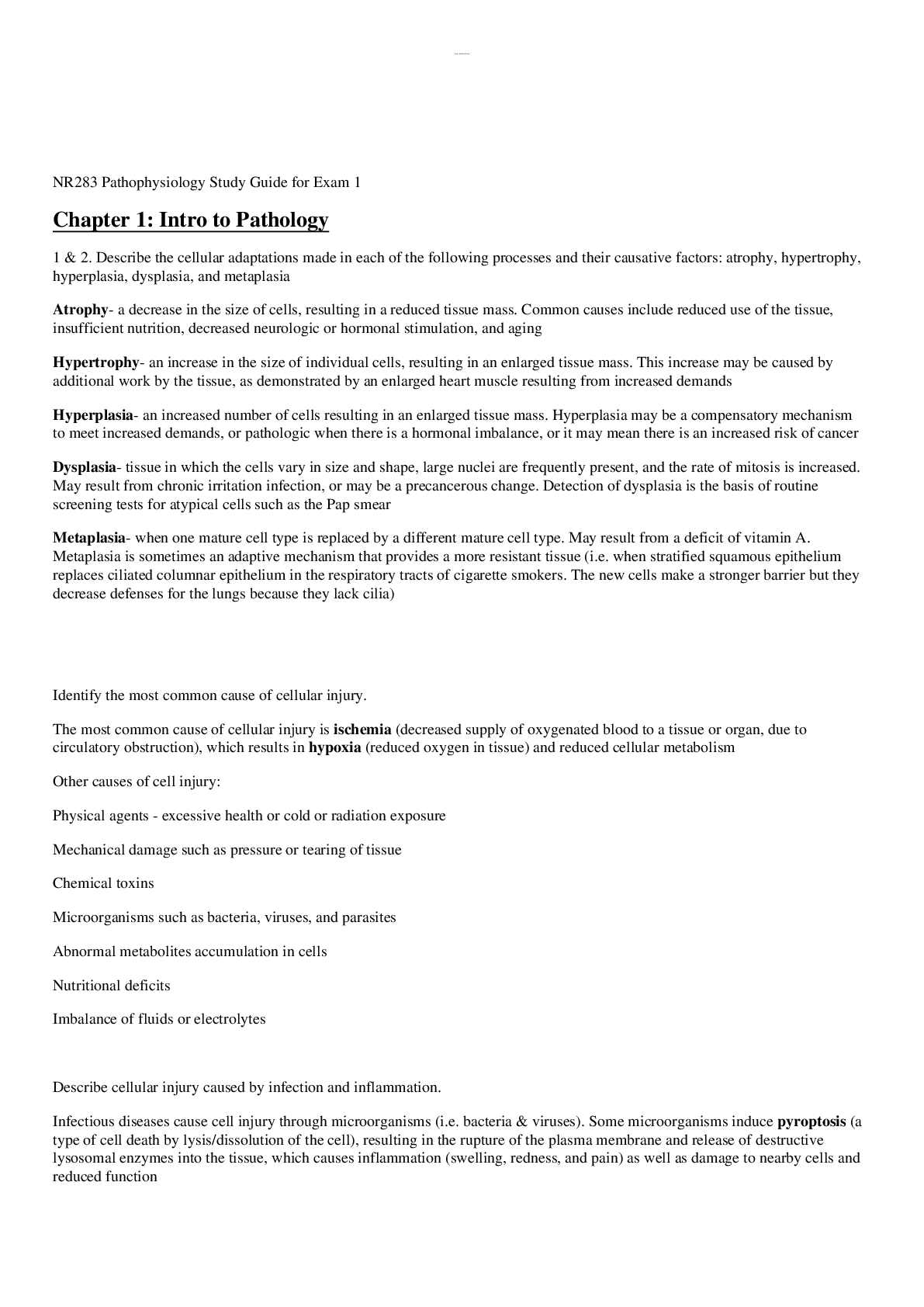

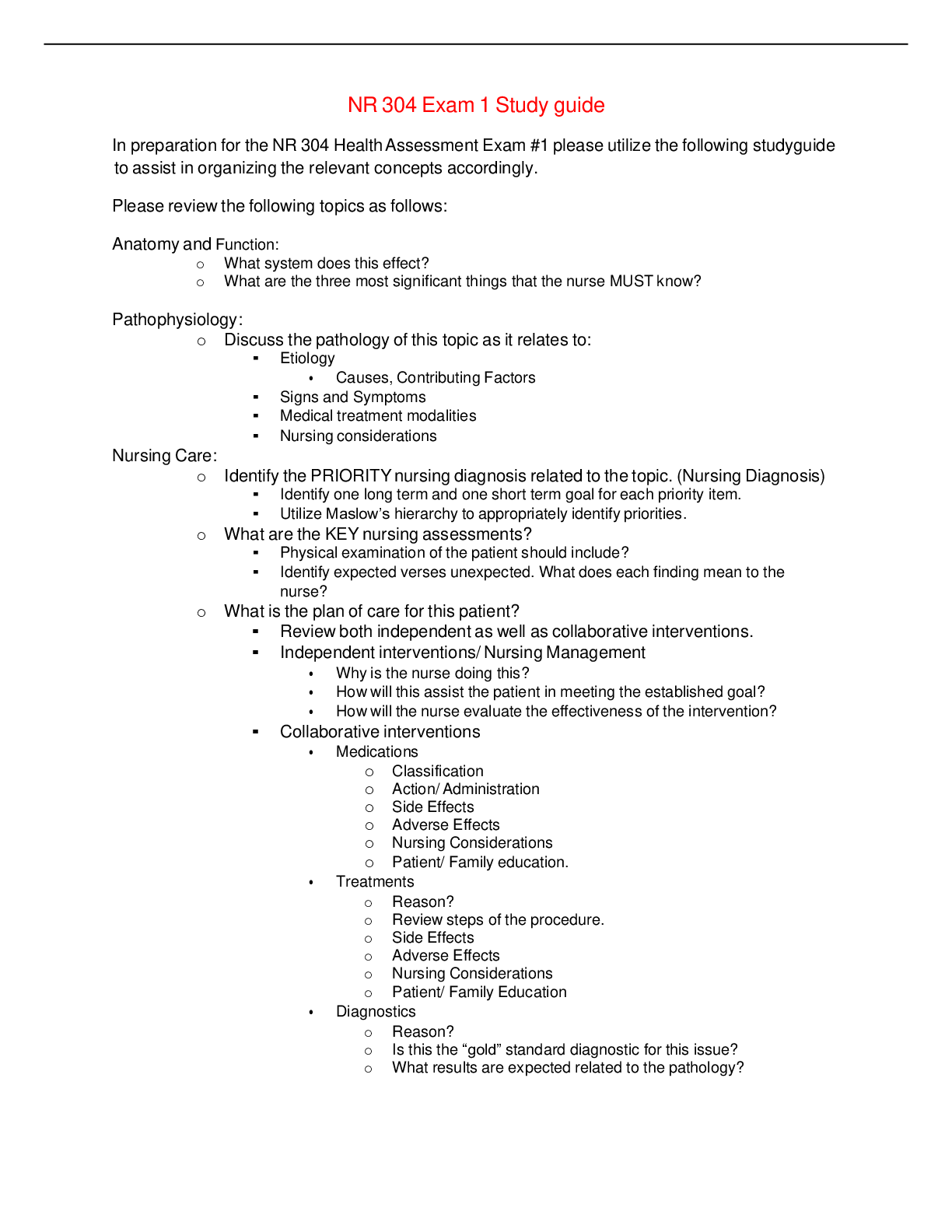
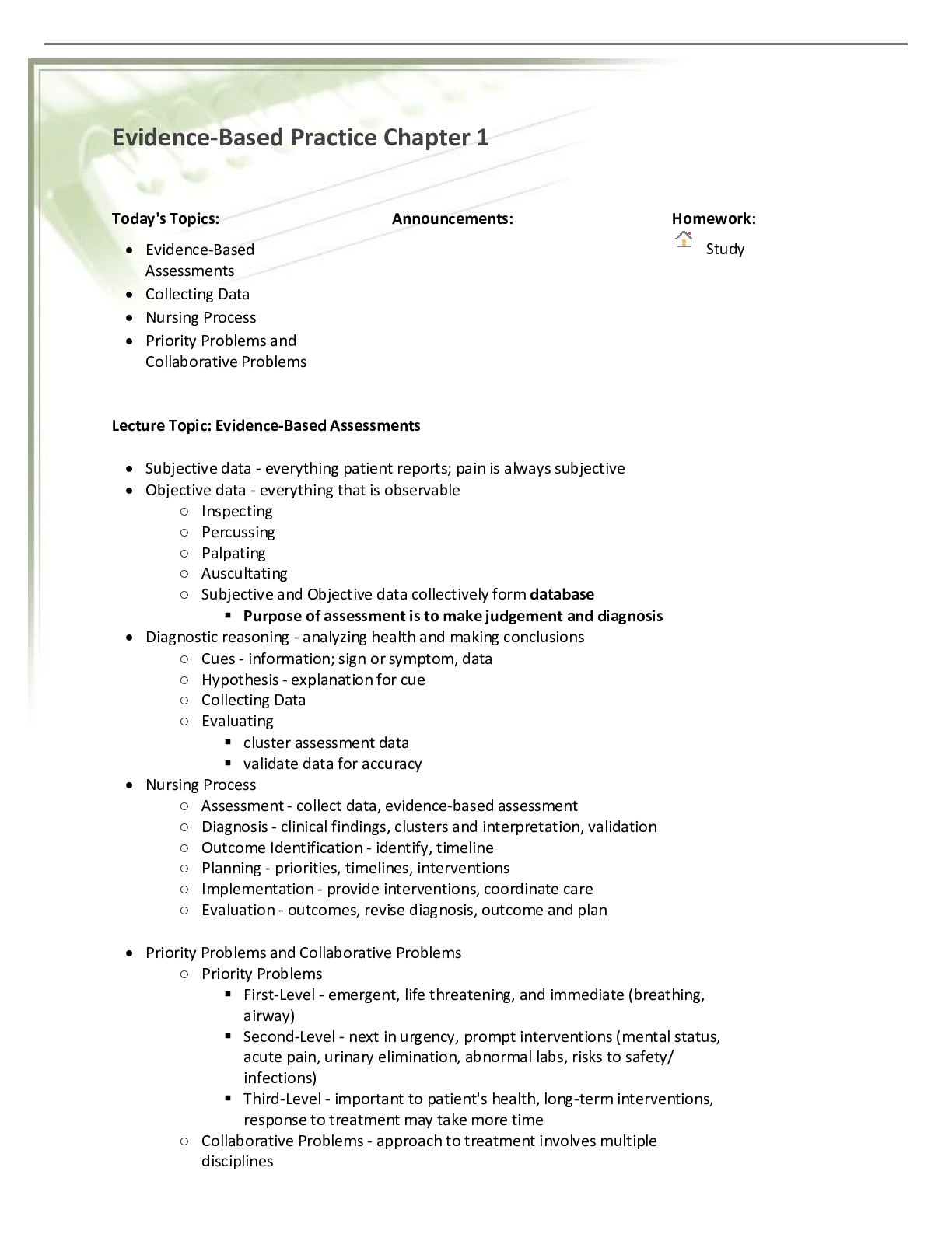

-3-168.png)
